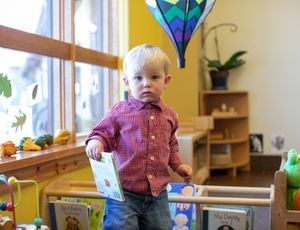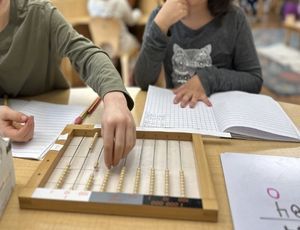During the first three years of life, children develop independence if they are encouraged to develop skills at their own pace and are allowed to safely explore their surroundings following their curiosity and natural need to explore. However, did you know that an average child hears the word “no” at least 400 times a day? That is an astonishing number. In this month´s article, we will discuss how to prepare a YES environment for your child and why it is vital to nourish the sense of wonder that children are naturally born with.
Dr. Maria Montessori observed that children under three years of age have a natural curiosity and zest for learning; there is no need to plant a seed of curiosity because they are already born with it. Instead, our role as adults is to prepare ourselves and the environment for the child to explore safely and make his own discoveries, primarily through touch and play.
We all need a “Yes” environment to do our best; an environment that is safe, positive, and allows freedom. Here are the five characteristics of a “Yes” environment for children:
- There is trust in the child: We must trust that the child wants to learn and grow; they intrinsically know what they should be doing and what they will do next. There is no need to worry about them not learning or learning at a different pace than other children. Every child is unique and has its own time. Trusting them also means to accept they can listen to their body. It might take some repetition and maybe one or two accidents along the way, but they are learning what their body can and cannot do yet. There is no need to be worried about it, but we will be there ready to help them if they need us, but not before.
- It is a rich, nourishing learning environment: It does not mean you need to fill the space with expensive materials that can be overwhelming. Instead, identify through observation what your child needs, prepare it for him, and allow plenty of practice and repetition until he masters that specific skill. Most importantly, allow concentration to develop, identify when you or other adults are being an obstacle for your child, and step back. This can happen indoors or outdoors; there are many elements to explore in both settings.
- Has no time limitations: Time is vital if we want children to develop and follow their urge to discover. Avoid rushing your child when exploring; there is no need to have a strict schedule for play. Also, remember that playing and exploring do not come only in the shape of play, but your child will also explore through movement, language, and purposeful conversations.
- It has a safe and secure base: We must provide the child an emotionally safe environment where he is being accepted for who he is, trusting that the adult will always be there even when the child is having a hard time. We should also provide a physically safe environment if we want to allow freedom of exploring; make sure there are no dangers in the environments for your child. Use outlet covers, remove tablecloths for children that might pull them, remove any small items that can be a shock hazard for those infants that explore items orally, etc.
- It has an adult that fosters a sense of wonder: We can ask children questions about the world they see. Invite your child to use all five senses to explore. Take him out to nature as often as possible and share with him the joy of living every single detail of the space as if it was the first time you have seen it.
Following the child does not mean permissiveness; instead, it is preparing the environment and setting limits when needed, ensuring safety and care for themselves, the environment, and others.
Remember, to protect the curiosity of every child, we must understand that the most important part of an experience is the process, not the product. Go slow and look at pavement cracks together, watch the leaves of the trees fall, etc.
Item of the Month
Rolling Cylinder with Balls
It is a wooden cylinder that rolls on the floor, encouraging infants to crawl and reach it. It is also a great item to manipulate since it has small balls that will make a sound when shaken, and it gives the infant immediate feedback about his movements.
Link to buy it on Amazon:
https://www.amazon.com/-/es/CutiePieToys-Montessori-tambor-rodante-cilindro/dp/B07VFCV2J3/ref=sr_1_2?__mk_es_US=%C3%85M%C3%85%C5%BD%C3%95%C3%91&keywords=rolling+cylinder+with+ball&qid=1582057847&sr=8-2
Quote of the Month
“The environment must be rich in motives which lend interest to activity and invite the child to conduct his own experiences.” - Maria Montessori
Have a Little Extra Time?
Grab your headphones and enjoy this 20-minute video of montessoriguide.org. It reflects upon the fact that young children have an internal desire to explore and learn. This desire is intrinsically affected by the environment where the child is, psychologically and physically. Enjoy!
Link to the video: https://vimeo.com/121147413



